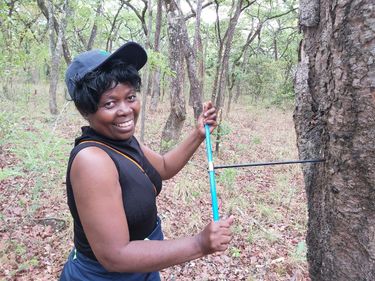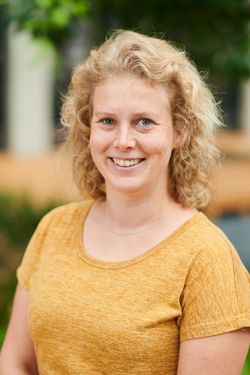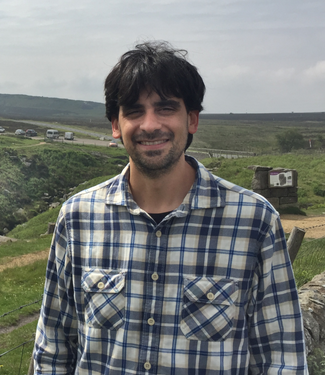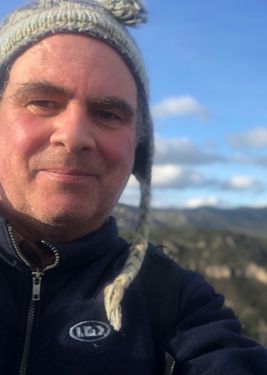
Stockton Maxwell
I'm an associate professor of Geospatial Science at Radford University (VA). My academic training is varied. I started out as a behavioral psychologist, moved onto forest ecology, and ended up as a biogeographer with ecological and climatological intentions. All of which are terribly interesting and continue to occupy my time. Researchwise, I specialize in applications of dendrochronology including forest disturbance history, carbon sequestration, and paleoclimate reconstruction. In addition to tree rings, I utilize statistical, ecological, and geospatial techniques to investigate a host of biogeographic ideas.
Sessions in which Stockton Maxwell participates
Tuesday 28 June, 2022
Wednesday 29 June, 2022
Dendroclimatology in the tropical forest regions has lagged behind the more temperate forested regions of the world because of the challenge of determining annual ring formation. Despite over 230 tropical tree species known to form annual rings, the ITRDB shows few published chronologies in tropical forests in Sub-Saharan Africa. As part of the first “Training in Tree-Ring Science and its Applications” workshop conducted in Kitwe, Zambia, our team explored the dendroclimatic potential of B...
Rescheduled from June 28th to June 29th
Sessions in which Stockton Maxwell attends
Monday 27 June, 2022
MAIDENiso is a numerical process-based model that allows researchers to simulate the growth of a virtual tree. Using daily meteorological data, the model simulates the physical and physiological processes taking place in the tree and its environment, to produce daily and yearly outputs comparable to dendrological observations. The model has been adapted and used successfully in boreal regions in North America. In an inverse mode, tree-ring obs...
Blue Intensity (BI) is a cost-effective analytical method for measuring relative wood density in the rings of conifer tree species. Since early concept papers in the 1990s/2000s, there has been a recent explosion in the application of this method for both dendroclimatology and historical dating as well as other dendro-disciplines. The beauty of BI is that the analytical costs, mainly related to the cost of a h...
Free, in person and onlineWe will hold a practical, skills-based workshop introducing openDendro -- an open-source framework of the base analytic software tools used in dendrochronology in both the R and Python programming languages. openDendro is a new unified set of tree-ring analysis tools in open-source environments that provides the necessary baseline for dendro...
Tuesday 28 June, 2022
Africa is faced with a number of challenges including climate change and ecological disturbance due to various anthropogenic activities. These problems adversely affect the forests and also ecosystem services. My appreciation for the forests motivated me to pursure my undergraduate studies in Forestry. I first applied dendrochronology during my PhD research which focused on understanding the climate change vulnerability of the Zambezi teak forests in Zambia. However, lack of research facil...
Tree-ring time series provide long-term, annually resolved information on the growth of individual trees. However, public tree-ring archives contain a considerable portion of data collected from trees that have been selected with specific research questions in mind (e.g., for climate reconstruction). This makes these archives a biased representation of the sensitivity of forest ecosystems to ongoing climate variation (e.g. temperature, precipitation), including non-stationarity (i.e....
Tree-ring time series provide long-term, annually resolved information on the growth of individual trees. However, public tree-ring archives contain a considerable portion of data collected from trees that have been selected with specific research questions in mind (e.g., for climate reconstruction). This makes these archives a biased representation of the sensitivity of forest ecosystems to ongoing climate variation (e.g. temperature, precipitation), including non-stationarity (i.e....
Wednesday 29 June, 2022
Dendrochronology is considered one the most precise of all the scientific dating techniques. However, it requires long sequences of tree rings and a master record for both the species and region in question. At the University of Groningen, we have been pioneering a new approach to dating that combines the precision of dendrochronology with the versatility of radiocarbon dating. It relies on the detection of spikes in the annual radiocarbon record, thought to b...
Information garnered from historical timbers and wooden artifacts (e.g. houses, barns, ships) can greatly enhance our understanding of human, ecological, and climate history, especially in regions where few old-growth forests and trees remain, tree longevity is relatively short (less than 300-400 years), and environmental conditions break down wood rather quickly, like in mesic to wet regions. Over the last decade plus, the application of tree-ring techniques on wo...
Information garnered from historical timbers and wooden artifacts (e.g. houses, barns, ships) can greatly enhance our understanding of human, ecological, and climate history, especially in regions where few old-growth forests and trees remain, tree longevity is relatively short (less than 300-400 years), and environmental conditions break down wood rather quickly, like in mesic to wet regions Over the last decade plus, the application of tree-ring techniques on woo...
The Tiger Creek Preserve in central Florida has one of the highest concentrations of threatened and endangered plants and animals in the United States. Historically it was probably a longleaf pine savanna, but fire exclusion in recent decades has almost certainly led to increased basal area by mid-story oaks (mainly Quercus geminata and Q. laevis). Determining the date of establishment of these trees, as well as the early fire history of the site, would provide evidence to supp...
"Multi-centennial to millennial-long oak ring width chronologies from living and relict wood are frequently used for climate reconstructions, but the amount of explained hydroclimatic variation remains relatively small. Although stable carbon and oxygen isotopic ratios (δ13C and δ18O values) in tree rings may offer enhanced climate sensitivity, our understanding of their paleoclimatic sensitivity is still limited by the general lack of well-replicated and high-resolution datasets. Here, we...
Trait plasticity supports tree growth and survival in multiple environments and is important at the edges of species ranges, with limited tree growth. Xylem anatomical traits determine sap, nutrient flow and mechanical strength. Trait analysis can provide information on species adaptation to extreme climatic conditions. My project studies xylem anatomical traits over the distribution range of the sugar maple in Quebec, where it finds its northern limit. We intend to understand the links be...
The Miombo woodlands of interior Africa are fire adapted ecosystems with a relatively open canopy dominated by Brachystegia spp., Julbernardia spp., and Isoberlina spp. These ecosystems are threatened due to deforestation, habitat fragmentation, and impacts from climate change, and in Zambia, they are further threatened by the rapidly growing mining industry which contributes to air pollution, contamination of soils and water, and land degradation. In this study, we used modified variable ...
Despite their potential benefits, streamflow reconstructions from tree-rings have not been widely used in water systems analysis because the flow is generally constructed at annual resolution, which may be too coarse for analysis of drought/flood vulnerability and decision making. In semi-arid regions of Chile there are very good relationships between these daily and annual flow, which is explained because within these regions, few hydrological events within a year explain most of the annu...
In eastern boreal Canada, in the absence of long gauge records, changes in tree-ring anatomy of periodically flooded trees have allowed reconstruction of spring floods in natural rivers. This study analyzes the effect of regulation on the flood rings (FR) occurrence and on ring widths in Fraxinus nigra trees growing at 5 sites distributed along the Driftwood River floodplain to determine if a flood reconstruction using FR could be done in regulated rivers. Driftwood River was regulated by ...
Photosynthesis and tree-growth are interconnected processes that are independently modulated by environmental variables. The lack of co-located high spatiotemporal resolution measurements of photosynthesis and growth has limited our understanding of their relationship with each other and their environment. Here, we study photosynthesis and tree-growth at near-instantaneous timescales using in-situ and satellite remote-remote sensing, point dendrometers, quantitative wood anatomy, and Pulse...
Fire-dependent red pine (Pinus resinosa Ait.) vegetation communities in the central Appalac...
Spatially-resolved climate field reconstructions are ideal for analyzing spatial anomaly patterns and characterizing regional-scale trends resultant from climate change. To date, few fine-scale, spatially-resolved paleotemperature datasets exist in the Northern Hemisphere. Here, we present a 2.5x2.5o temperature field reconstruction of warm season (April-August) mean surface air temperatures, developed from a network of 130 tree-ring chronologies. In the reconstruction’s current form, stat...
This is a mandatory (!) .... and FREE (!!) cocktail & award ceremony (!!!)(in replacement of the Banquet formula)->->->->->->->->->->->->->->->->->->After a great summer day of scientific and urban discoveries in our beloved MTL, we wish to bring together all the AmeriDendro community in one place and congratulate the TRS awardees for their remarkable achievements! -Bonsinsegna award-Fr...
Thursday 30 June, 2022
How old are tropical trees? This fundamental question has long driven the curiosity of laymen and scientists. But only recently, a great number of studies conducted by many brave dendrochronologists resulted in a significant tree-ring-based knowledge that allows us to start accurately estimating tree ages across the globe. As science goes, not only knowing the longevity of tropical trees is essential to understanding forest dynamics and its role in biogeochemical cycles, but one must also ...
Dendrochronological archives in the tropics of the Americas have been under-studied for a long time. Some of the challenges include the Identification of tree-ring boundaries in certain tree species, absence of winter dormancy associated to low temperatures in most of the cases, and logistic difficulties of fieldwork in remote sites. However, part of the slow progress is also related to the fact that historically much less resources have been inv...
Dendrochronological archives in the tropics of the Americas have been under-studied for a long time. Some of the challenges include the Identification of tree-ring boundaries in certain tree species, absence of winter dormancy associated to low temperatures in most of the cases, and logistic difficulties of fieldwork in remote sites. However, part of the slow progress is also related to the fact that historically much less resources have been inv...
In their book chapter in 2011 Gagen et al. (2011) highlighted the need for stable isotope dendroclimatology to move beyond studies that simply demonstrate ‘potential’. This symposium, more than a decade since this publication, will focus on dendrogeochemical studies that demonstrate that the field has moved beyond studies focused on ‘potential’. In particular, this session will strive to identify compelling new insights into unique aspect...
A gap of millennial tree-ring data suitable for dendroclimatology has long been evident in the North American boreal forest. In my talk, I will describe the adaptive approach we have developed to build and improve a data network for millennial dendroclimatology in the eastern Canadian taiga. Recurrence of stand replacing wildfires is the most important constrain to the elaboration of long tree ring chronologies, which can only be developed away from regions ...
The interpretation of stable isotopes in a dendroecological framework can provide powerful insights into how trees adjust physiologically in response to the environment. This symposium aims to bring together researchers who use stable isotopes in tree rings to address ecophysiological responses to environmental changes from intra-annual to multi-decadal resolution. We hope this symposium will enable fruitful discussions and new ideas a...
Allies have emerged as key enablers of diversity and inclusivity initiatives in the workplace, in professional associations, and in everyday life. But what is an ally? What skills are required to be an effective ally? How do we hold ourselves and our community members accountable for being effective allies? This symposium will provide a deeper understanding of what it means to be an ally and the skills to help advance allyship as individuals and as a community. Fur...
(by bus, max 92 people)Designed for visitors and newcomers, the tour is based on the pleasure...




